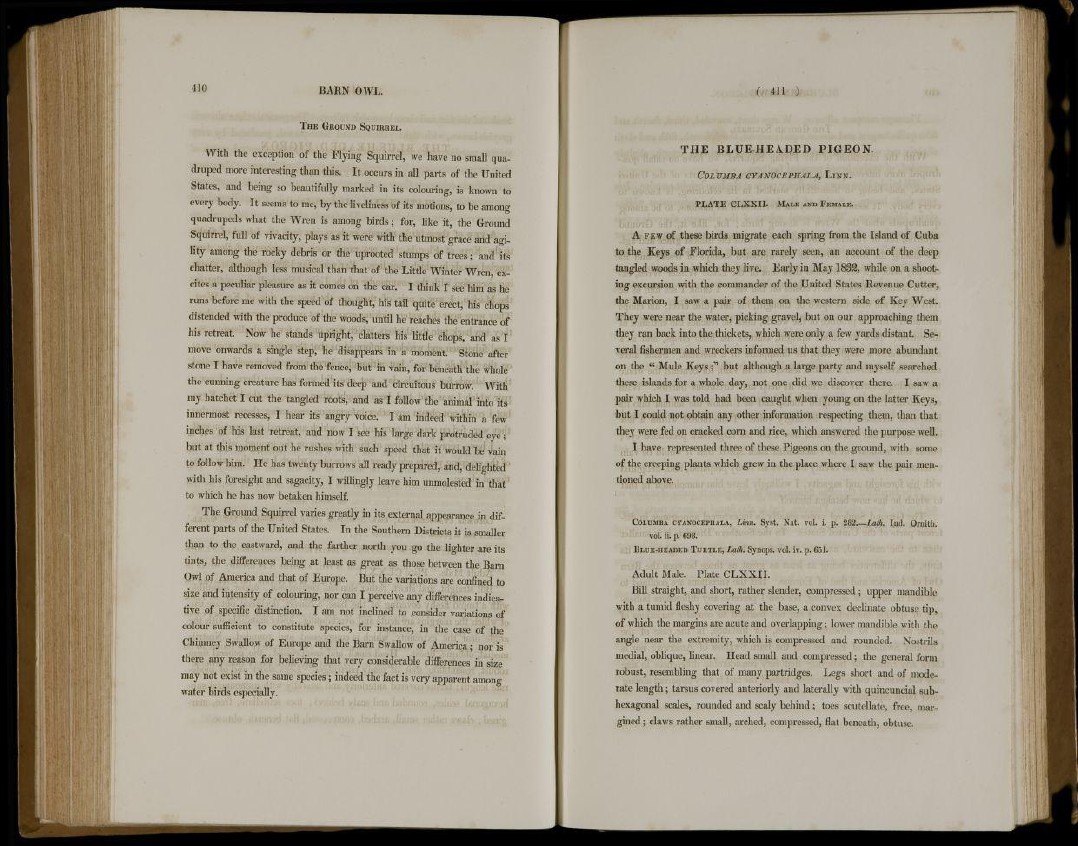
410 BARN OWL.
THE GROUND SQUIRREL.
With the exception of the Flying Squirrel, we have no small quadruped
more interesting than this. It occurs in all parts of the United
States, and being so beautifully marked in its colouring, is known to
every body. It seems to me, by the liveliness of its motions, to be among
quadrupeds what the Wren is among birds; for, like it, the Ground
Squirrel, full of vivacity, plays as it were with the utmost grace and agility
among the rocky debris or the uprooted stumps of trees; and its
chatter, although less musical than that of the Little Winter Wren, excites
a peculiar pleasure as it comes on the ear. I think I see him as he
runs before me with the speed of thought, his tail quite erect, his chops
distended with the produce of the woods, until he reaches the entrance of
his retreat. Now he stands upright, clatters his little chops, and as I
move onwards a single step, he disappears in a moment. Stone after
stone I have removed from the fence, but in vain, for beneath the whole
the cunning creature has formed its deep and circuitous burrow. With
my hatchet I cut the tangled roots, and as I follow the animal into its
innermost recesses, I hear its angry voice. I am indeed within a few
inches of his last retreat, and now I see his large dark protruded eye;
but at this moment out he rushes with such speed that it would be vain
to follow him. He has twenty burrows all ready prepared, and, delighted
with his foresight and sagacity, I willingly leave him unmolested in that
to which he has now betaken himself.
The Ground Squirrel varies greatly in its external appearance in different
parts of the United States. In the Southern Districts it is smaller
than to the eastward, and the farther north you go the lighter are its
tints, the differences being at least as great as those between the Barn
Owl of America and that of Europe. But the variations are confined to
size and intensity of colouring, nor can I perceive any differences indicative
of specific distinction. I am not inclined to consider variations of
colour sufficient to constitute species, for instance, in the case of the
Chimney Swallow of Europe and the Barn Swallow of America; nor is
there any reason for believing that very considerable differences in size
may not exist in the same species ; indeed the fact is very apparent among
water birds especially.
( 411 )
T H E BLUE-HEADED PIGEON.
COLUMBA CYANOCEPHALA, LlNN.
PLATE CLXXIL MALE AND FEMALE.
A F EW of these birds migrate each spring from the Island of Cuba
to the Keys of Florida, but are rarely seen, an account of the deep
tangled woods in which they live. Early in May 1832, while on a shooting
excursion with the commander of the United States Revenue Cutter,
the Marion, I saw a pair of them on the western side of Key West.
They were near the water, picking gravel, but on our approaching them
they ran back into the thickets, which were only a few yards distant. Several
fishermen and wreckers informed us that they were more abundant
on the " Mule Keys •,v> but although a large party and myself searched
these islands for a whole day, not one did we discover there. I saw a
pair which I was told had been caught when young on the latter Keys,
but I could not obtain any other information respecting them, than that
they were fed on cracked corn and rice, which answered the purpose well.
I have represented three of these Pigeons on the ground, with some
of the creeping plants which grew in the place where I saw the pair mentioned
above.
COLUMBA CYANOCEPHALA, Linn. Syst. Nat. vol. i. p. 282.—Lath. Iud. OrniUi.
vol. ii. p. 698.
13LUE-HEADED TURTLE, Lath. Synops. vol. iv. p. 6 5 1 .
Adult Male. Plate CLXXIL
Bill straight, and short, rather slender, compressed ; upper mandible
with a tumid fleshy covering at the base, a convex decimate obtuse tip,
of which the margins are acute and overlapping; lower mandible with the
angle near the extremity, which is compressed and rounded. Nostrils
medial, oblique, linear. Head small and compressed; the general form
robust, resembling that of many partridges. Legs short and of moderate
length; tarsus covered anteriorly and laterally with quincuncial subhexagonal
scales, rounded and scaly behind; toes scutellate, free, margined
; claws rather small, arched, compressed, flat beneath, obtuse.